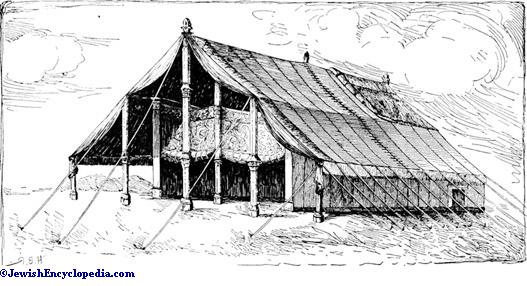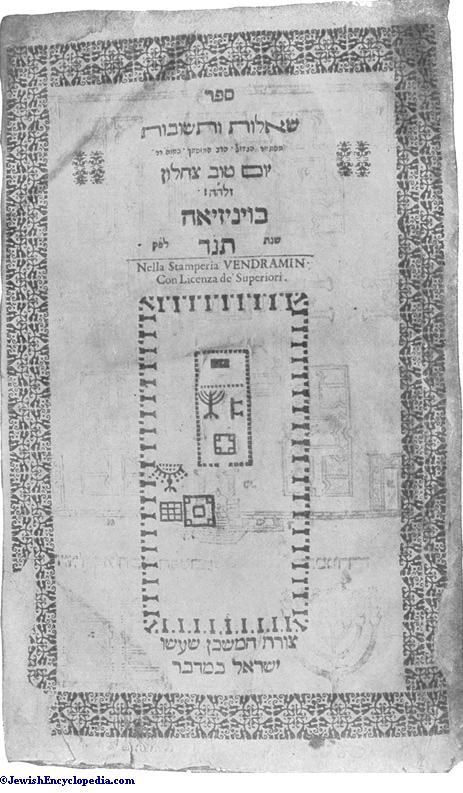TABERNACLE:
The portable tent-like structure that served the Israelites as a sanctuary during their wanderings in the wilderness and in the early period of their life in Palestine. It is chiefly in Ex. xxvi. and its parallel, ib. xxxvi. 8-38, that the oldest sanctuary of
Since this framework was of course the first part to be set up (ib. xl. 18), it has been mentioned first here; but what really constituted the dwelling of the Lord, according to the express words of the Old Testament (ib. xxvi. 1, 6; xxxvi. 8, 13), were the inner curtains, which gave the structure its characteristic form. The quality and colors of these curtains were chosen accordingly; they were woven from the finest threads, some white, some bluish and reddish purple, and some scarlet. Pictures of cherubim were also woven in them (ib. xxvi. 1-6). A second set of curtains was made of goat-hair, which was the usual material for tents (ib. verses 7-13); these, by synecdoche (comp. König, "Stilistik," etc., p. 64), were called the "tent" (ib. xxvi. 7; xxxviii. 14, 18; xl. 19), inasmuch as they formed the chief part thereof; and upon them were placed two coverings, one of ramskin dyed red, and one of skins of the "taḥash." This latter was probably a seal; in any case it was a less common animal than the sheep, which Friedrich Delitzsch in his "Prolegomena zu einem Neuen Hebräisch-Aramäischen Wörterbuch" (p. 79) understands by "taḥash." With regard to the first-mentioned curtains, some scholars, as Winer("B. R." s.v.) and Holzinger (on Ex. xxvi. 15, in "K. H. C." 1900), have declared that they formed not the walls of the Tabernacle, but merely an inner covering of those walls; but the contrary view is much more probable, and is the one adopted by De Wette, for instance ("Hebräische Archäologie," § 194), by Riehm ("Handwörterbuch des Biblischen Altertums," p. 1559), and by Baentsch ("Handkommentar zum Exodus," 1900, p. 228); indeed, the circumstance that these curtains are called "the dwelling" and that the tent-covering is placed upon them (Ex. xl. 19) is convincing evidence for the opinion that they enveloped the boards almost completely lest they might become soiled; they were not to touch the floor, and so were made only 28 cubits long. This fact would not be so comprehensible had the curtains been merely interior hangings. The objection has been raised, it is true, that cherubim were woven into them, and that in Solomon's Temple cherubim were carved on the inner walls; but the latter case presents a necessary modification which resulted naturally when the dwelling of the Lord no longer consisted chiefly of curtains. Moreover, the text contains no suggestion of hooks or any other appliances by means of which the curtains might have been suspended had they been intended merely to cover the inner surface of the walls.
Size.

The examination of the component parts of
This tent was divided, by means of a curtain hung 10 cubits from the western wall, into a most holy place ("Ḳodesh ha-Ḳodashim") and a holy place ("Ḳodesh"). This curtain was called "paroket," and was woven from the same four stuffs as the costly curtains which formed the inner covering (Ex. xxvi. 31-35). The eastern entrance to the holy place, which was 20 cubits long, was covered by a curtain ("masak") of the same materials (ib. verses 36 et seq.). Finally a court (ḥaẓer) formed in a certain measure a part of the Tabernacle. This court was 100 cubits long and 50 cubits broad (ib. xxvii. 9-13), and, since the Tabernacle was placed in its western part, it was rightly called a forecourt. The Tabernacle could be taken down (Num. x. 17); and it is therefore called a "tent." Its form does not need to have been that of a house (namely, that of Solomon's Temple), since (despite Holzinger's [l.c. p. 129] and Baentsch's [l.c. p. 231] statements) tents are sometimes made in an elongated form.
Name.As has been mentioned above, this sanctuary of
It was natural that the Ark of the Covenant should have been erected in some protected place; and such a place is expressly mentioned in Ex. xxxiii. 7-11 (which section is correctly ascribed to a comparatively ancient chronicler), and is called "ohel mo'ed." It is, to be sure, stated in the same place that Moses used to set up the Tabernacle outside of the camp (comp. König, "Syntax," §§ 157, 367e), and its position is so designated in Num. x. 32; xi. 24, 26 et seq., 30; xii. 4, whereas according to Num. ii. 2, 17; v. 1 et seq., the ohel mo'ed formed the central point of the camp. This obscurity in the memory of Israel is not to be denied; but, nevertheless, the question remains as to whether or not the Tabernacle, the description of which has been given above, is to be treated as a pure invention of the later priests, as is claimed by many exegetes and with special emphasis by Baentsch (l.c. p. 220). The argument that the splendor with which the Tabernacle was furnished according to Ex. xxvi. 1 et seq., precludes its assignment to the time of Moses is of no weight, since the passage Ex. iii. 22 et seq. does not admit the conclusion that the Israelites who came out of Egypt were wholly destitute. Moreover, it is not remarkable, as has been claimed, that the tent of meeting should sometimes have been called "house" ("bayit"; comp. Josh. xviii. with Judges xviii. 31), since the tent which David erected for the Ark of the Covenant (II Sam. vi. 17) is similarly called "house of Jehovah" (ib. xii. 20); and if the Tabernacle was a product of the imagination, with Solomon's Temple as its prototype, other differences between the descriptions of the two would be hard to explain (e.g., one candlestick instead of ten).
Symbolic Meaning.It is probable that the characteristic features of the place of worship in the Old Testament bore, in addition to their outward purpose, an inner relationship to religious ideas. The following may be considered the chief of these: the opening of the gate toward the east had reference to the rising of the sun (comp. Isa. xli. 1 et seq.); the distinction between the holy place and the most holy place corresponded to the distinction between heaven and the innermost heaven ("sheme ha-shamayim"; I Kings viii. 27, etc.); and the forecourt, according to Isa. lxvi. 1, symbolized the earth. This interpretation was suggested by Josephus (l.c. iii. 6. § 4), and has been developed chiefly by Bähr ("Symbolik des Mosaischen Kultus," 1837).



